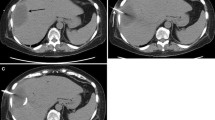Abstract
Background
Appendicitis is the most common cause of an acute abdomen in children. With perforation, multiple intraperitoneal collections can be seen at presentation. In this situation, surgical treatment alone is rarely effective.
Objective
To determine the role of image-guided drainage in treating patients with acute appendicitis complicated by multiple intraabdominal collections.
Materials and methods
A retrospective review of patient charts and interventional radiology records was performed to identify all patients with acute complicated appendicitis treated by multiple image-guided drainage procedures. Data reviewed included the number of drainages and aspirations performed, drain dwell time, the clinical course and temperature profile, and the length of inpatient hospital stay and any complications experienced.
Results
The study population comprised 42 children with a mean age of 107.6 months. A total of 100 drainage catheters were inserted and 56 aspirations were performed. Of the 42 children, 24 were successfully treated at a single sitting, while 18 returned for further intervention. The mean drain dwell time was 8.18 days. The mean inpatient stay was 15.02 days. Treatment of the acute presentation with image-guided intervention was successful in 92.3% of children.
Conclusion
Successful management of acute perforated appendicitis with multiple intraabdominal abscesses can be achieved with multiple minimally invasive image-guided drainage procedures.



Similar content being viewed by others
References
Hale DA, Molloy M, Pearl RH et al (1997) Appendectomy: a contemporary appraisal. Ann Surg 225:252–261
Kokoska ER, Silen ML, Tracy TF Jr et al (1998) Perforated appendicitis in children: risk factors for the development of complications. Surgery 124:619–625
Fulcher AS, Turner MA (1996) Percutaneous drainage of enteric-related abscesses. Gastroenterologist 4:276–285
Jamieson DH, Chait PG, Filler R (1997) Interventional drainage of appendiceal abscesses in children. AJR 169:1619–1622
vanSonnenberg E, Wittich GR, Casola G et al (1987) Periappendiceal abscesses: percutaneous drainage. Radiology 163:23–26
Ein SH, Langer JC, Daneman A (2005) Nonoperative management of pediatric ruptured appendix with inflammatory mass or abscess: presence of an appendicolith predicts recurrent appendicitis. J Pediatr Surg 40:1612–1615
Piskun G, Kozik D, Rajpal S et al (2001) Comparison of laparoscopic, open, and converted appendectomy for perforated appendicitis. Surg Endosc 15:660–662
Horwitz JR, Custer MD, May BH et al (1997) Should laparoscopic appendectomy be avoided for complicated appendicitis in children? J Pediatr Surg 32:1601–1603
Oliak D, Yamini D, Udani VM et al (2001) Initial nonoperative management of periappendiceal abscess. Dis Colon Rectum 44:936–941
Brown CV, Abrishami M, Muller M et al (2003) Appendiceal abscess: immediate operation or percutaneous drainage? Am Surg 69:829–832
Doberneck RC, Mittelman J (1982) Reappraisal of the problems of intra-abdominal abscess. Surg Gynecol Obstet 154:875–879
Nadler EP, Reblock KK, Vaughan KG et al (2004) Predictors of outcome for children with perforated appendicitis initially treated with non-operative management. Surg Infect (Larchmt) 5:349–356
Chung T, Hoffer FA, Lund DP (1996) Transrectal drainage of deep pelvic abscesses in children using a combined transrectal sonographic and fluoroscopic guidance. Pediatr Radiol 26:874–878
Pereira JK, Chait PG, Miller SF (1996) Deep pelvic abscesses in children: transrectal drainage under radiological guidance. Radiology 198:393–396
Author information
Authors and Affiliations
Corresponding author
Rights and permissions
About this article
Cite this article
McCann, J.W., Maroo, S., Wales, P. et al. Image-guided drainage of multiple intraabdominal abscesses in children with perforated appendicitis: an alternative to laparotomy. Pediatr Radiol 38, 661–668 (2008). https://doi.org/10.1007/s00247-008-0816-y
Received:
Revised:
Accepted:
Published:
Issue Date:
DOI: https://doi.org/10.1007/s00247-008-0816-y




